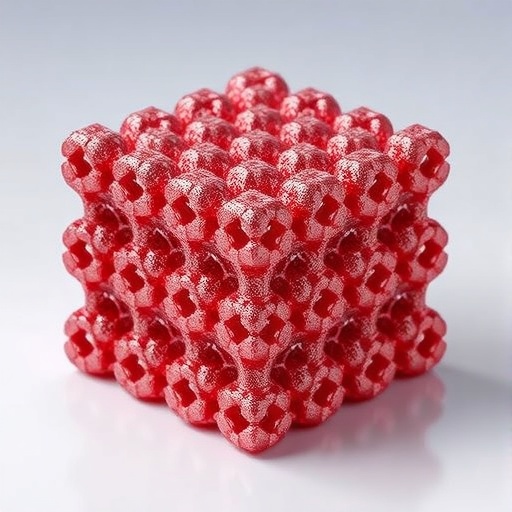The ongoing quest for energy storage solutions has reached a pivotal point with the recent groundbreaking research on vanadium pentoxide (V₂O₅) micro hexagons. This innovative form of vanadium pentoxide is poised to revolutionize the supercapacitor technology, enhancing energy density, charge-discharge rates, and overall performance. Researchers Ranu, Bhosale, and Desarada have meticulously employed a hydrothermal method to synthesize these micro hexagons, showcasing their potential applications in the realm of energy storage devices.
Supercapacitors, as one of the most promising energy storage systems, bridge the gap between traditional capacitors and rechargeable batteries. They are characterized by their ability to deliver high power densities and rapid charge-discharge cycles, making them essential in modern technologies such as electric vehicles, portable electronics, and renewable energy systems. However, the development of materials that can optimize these properties remains a significant challenge in the field. The synthesis of V₂O₅ micro hexagons represents a crucial step towards overcoming these challenges.
The hydrothermal synthesis method employed in this study is particularly noteworthy due to its effectiveness in controlling the morphology of the resulting V₂O₅. Hydrothermal techniques utilize high-pressure and high-temperature conditions to facilitate chemical reactions in a solvent. This method not only yields high purity materials but also allows for the formation of unique structures such as hexagons. The specific geometric arrangement of these micro hexagons is believed to provide enhanced surface area, facilitating a higher number of active sites for electrochemical reactions.
One of the remarkable features of V₂O₅ micro hexagons is their structural stability and conductivity. These two characteristics are critical for supercapacitor applications. In the realm of energy storage, structural integrity must be maintained during charge-discharge cycles to prevent material degradation, which can drastically reduce performance. The researchers have observed that the hexagonal configuration provides mechanical strength, allowing the material to withstand repeated cycles without significant loss of efficiency.
Moreover, conductivity is essential for facilitating electron transfer within the supercapacitor. The unique morphology of V₂O₅ micro hexagons potentially enhances the electronic pathway, which is essential for quick charge transfers. This aspect of their research emphasizes the interrelation between material morphology and performance, suggesting that by optimizing the shape and size of active materials, performance metrics could be significantly improved.
In their experiments, the research team characterized the micro hexagons using various techniques, including scanning electron microscopy (SEM) and X-ray diffraction (XRD). These methods help in understanding the crystalline nature and the surface characteristics of the synthesized materials. Such techniques provide valuable insight into the structural properties, further validating the choice of hydrothermal synthesis for producing high-quality V₂O₅.
When integrated into supercapacitor devices, these micro hexagons exhibit remarkable electrochemical performance. Initial tests reveal high specific capacitance values, especially when compared to conventional materials used in supercapacitors. The material’s ability to store and release energy efficiently positions it as an exceptional candidate for next-generation energy storage systems, particularly in renewable energy applications where rapid charge cycles are essential.
The implications of this research extend beyond just supercapacitors; the same principles could be applied to batteries and hybrid energy storage systems. As the world transitions to greener energy solutions, the demand for effective energy storage solutions will only continue to grow. By advancing materials science and engineering, this research paves the way for safer, more efficient energy technologies that could play a critical role in reducing reliance on fossil fuels.
One of the intriguing prospects of using V₂O₅ micro hexagons is their versatility in adapting to different configurations and sizes, depending on the application. This adaptability might open avenues for the design of bespoke energy storage systems tailor-made for specific uses, ranging from small electronic devices to large-scale energy grids. Such flexibility could lead to a paradigm shift in how we approach energy storage solutions.
Furthermore, the synthesis method discussed demonstrates the potential for scalability. The hydrothermal process is not only effective but can also be adapted for large-scale production, making the transition from laboratory to commercial applications feasible. This scalability could significantly reduce costs and improve the accessibility of advanced energy storage technologies.
In summary, Ranu and colleagues have laid the groundwork for a significant advancement in the field of energy storage through the synthesis of V₂O₅ micro hexagons using a hydrothermal method. Their work highlights the crucial relationship between material structure and performance in supercapacitors, offering insights that could accelerate the development of new energy solutions. As we stand on the cusp of energy innovation, the findings from this research are set to inspire further exploration into materials that will shape the future of energy storage.
The combination of high performance, structural integrity, and the potential for scalable production makes V₂O₅ micro hexagons a material of choice for the next generation of supercapacitors and energy storage solutions. Researchers and industry experts alike are poised to watch closely as these developments unfold, ensuring a sustainable and efficient energy landscape for future generations.
Subject of Research: The synthesis and application of vanadium pentoxide (V₂O₅) micro hexagons in supercapacitors.
Article Title: Synthesis of vanadium pentoxide (V₂O₅) micro hexagons for supercapacitor application using hydrothermal method.
Article References:
Ranu, R., Bhosale, S.R., Desarada, S.V. et al. Synthesis of vanadium pentoxide (V2O5) micro hexagons for supercapacitor application using hydrothermal method.
Ionics (2025). https://doi.org/10.1007/s11581-025-06763-7
Image Credits: AI Generated
DOI: 04 November 2025
Keywords: vanadium pentoxide, micro hexagons, supercapacitors, hydrothermal method, energy storage, electrochemical performance, morphology.
Tags: charge-discharge performanceelectric vehicle energy solutionsEnergy Storage Solutionshigh power density materialshydrothermal synthesis methodinnovative energy storage devicesoptimizing energy storage materialsportable electronics energy efficiencyrenewable energy storage systemssupercapacitor technology advancementsV2O5 micro hexagonsvanadium pentoxide applications





